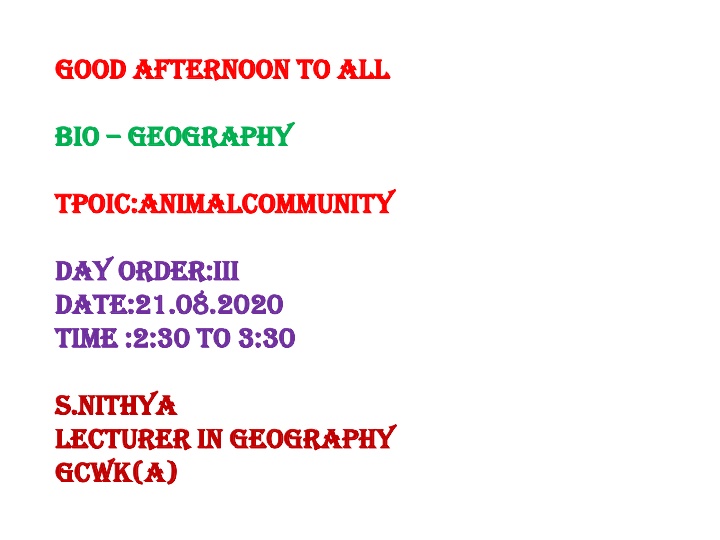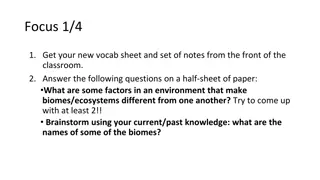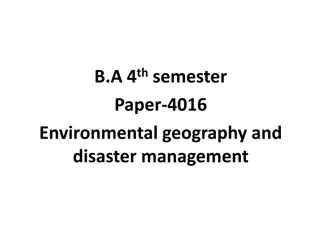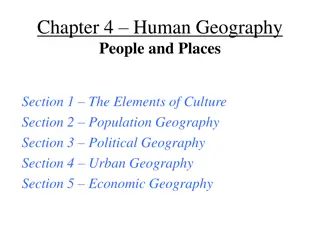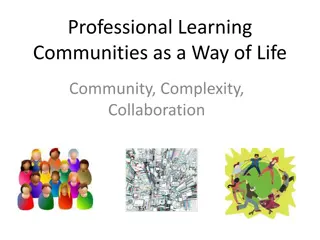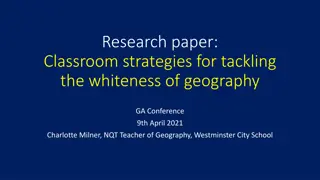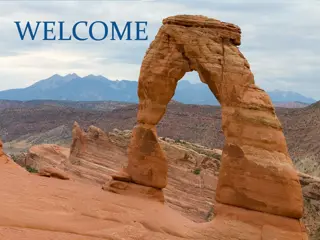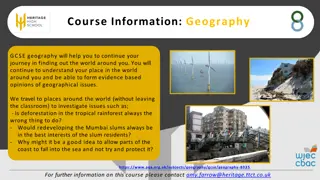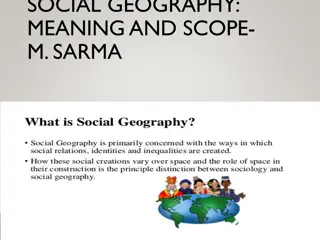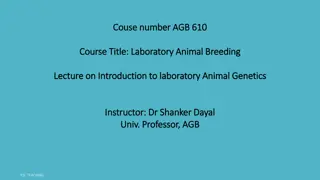Animal Communities in Geography
Animal communities are formed by various species occupying the same habitat or microhabitat, interacting within a biological community. Each species has a unique ecological niche, influencing interactions like competition and predation. Communities consist of producers, herbivores, carnivores, and more, organized into trophic levels along food chains. Explore the dynamic relationships within these ecosystems.
Download Presentation

Please find below an Image/Link to download the presentation.
The content on the website is provided AS IS for your information and personal use only. It may not be sold, licensed, or shared on other websites without obtaining consent from the author.If you encounter any issues during the download, it is possible that the publisher has removed the file from their server.
You are allowed to download the files provided on this website for personal or commercial use, subject to the condition that they are used lawfully. All files are the property of their respective owners.
The content on the website is provided AS IS for your information and personal use only. It may not be sold, licensed, or shared on other websites without obtaining consent from the author.
E N D
Presentation Transcript
GOOD AFTERNOON TO ALL GOOD AFTERNOON TO ALL BIO BIO GEOGRAPHY GEOGRAPHY TPOIC:ANIMALCOMMUNITY TPOIC:ANIMALCOMMUNITY DAY ORDER:III DAY ORDER:III DATE:21.08.2020 DATE:21.08.2020 TIME :2:30 TO 3:30 TIME :2:30 TO 3:30 S.NITHYA S.NITHYA LECTURER IN GEOGRAPHY LECTURER IN GEOGRAPHY GCWK(A) GCWK(A)
Species: Species: Individual organisms that Individual organisms that can interbreed to make fertile off can interbreed to make fertile off springs springs Population: Population: Total number of a Total number of a species in a given place/time species in a given place/time Community: Community: A combination of more A combination of more than one population in a place than one population in a place Therefore: Animal Community is Therefore: Animal Community is simply the various species of simply the various species of animals in an habitat or microhabitat animals in an habitat or microhabitat or occupying the same niche. or occupying the same niche.
ANIMAL COMMUNITY If one considers all of the various If one considers all of the various populations that are found in a given populations that are found in a given area, that is known as a biological area, that is known as a biological community. community. For example, all the organisms living For example, all the organisms living on a dead tree can be considered a on a dead tree can be considered a community. Various species of worms, community. Various species of worms, insects, moles, moss, insects, moles, moss, fungi, etc. will all reside there and carry out various all reside there and carry out various niches. niches. fungi, etc. will
Community Community, also called biological community community, in biology, an interacting group of various species in a common location. For example, a forest of trees and undergrowth plants, inhabited by animals and rooted in soil containing bacteria and fungi, constitutes a biological community. biological
The various species in a community each occupy their own ecological niche. The niche of a species includes all of its interactions with other members of the community, including competition, predation, parasitism, and mutualism. The organisms within a community can be positioned along food chains by showing which eats which, and these positions are known as trophic levels. The first level includes the producers the photosynthetic plants which convert the Sun s radiant energy into nutrients available to other organisms in the community. These plants are eaten by herbivores (plant-eaters, or primary consumers), the second trophic level. Herbivores are, in turn, eaten by carnivores (flesh-eaters), which are frequently eaten by larger carnivores (secondary and tertiary consumers, respectively). The food chain ends when the last link dies and is attacked by various bacteria and fungi, the decomposers that break down dead organic matter and thereby release essential nutrients back into the environment.
THANKS THANKS TO ALL TO ALL
